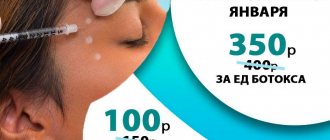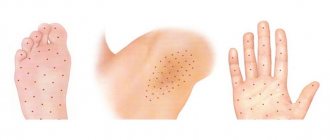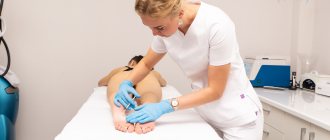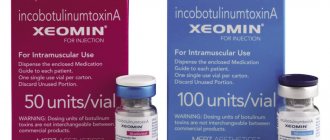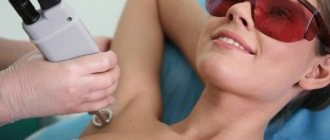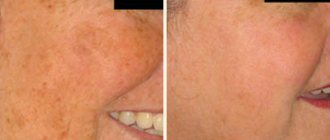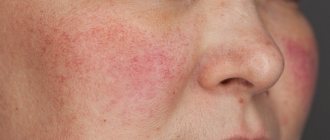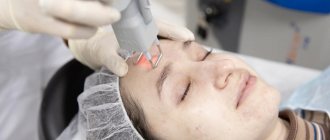Tired of constantly choosing clothes that won't show armpit sweat? Even the most “breathable” shoes don’t help get rid of excessive sweating on your feet? Or do your hands sweat, making it difficult to communicate with other people?
There is no need to think long and waste time using various antiperspirants, ointments or talkers! Intradermal injection of botulinum toxin will relieve hyperhidrosis for 8-12 months, after which the injections can be repeated. The procedure is safe and feels no different from beauty injections. After undergoing treatment for hyperhidrosis, you will again be able to regain the psychological comfort that you had before the problem appeared!
Surgical treatment of axillary hyperhidrosis using the FOTONA Nd:YAG XP 2 laser
Sweating is a normal function of the body to cool and regulate temperature. Excessive sweating is a generalized or localized disorder where the sweat glands work above normal levels. In case of systematic hyperhidrosis
treatment of this simple disorder is necessary, and although in case of proper hygiene and wearing clothes made from natural materials, it is enough to use antiperspirants, but in order to completely remove this disorder, surgery is necessary.
Hyperhidrosis
in the armpit area - this is a very unpleasant condition for men and women of all ages, especially during the summer.
An additional inconvenience is the appearance of sweat stains on clothes around the armpits. Hyperhidrosis
can be either constant or recurring.
Due to trends in modern society and communication media, a quality solution for hyperhidrosis
in the armpit area.
When botulinum toxin is injected into the armpits, hyperhidrosis
temporarily disappears for a period of 4 to 8 months.
Of the available surgical methods, the most widely used method is thoracic sympacectomy, but it has some contraindications (pneumothorax).
Removal of subcutaneous tissue is the most commonly used method of local surgery, with or without skin removal, or a partial combination of both procedures.
Permanent removal of axillary hyperhidrosis
and partial hair removal are resolved through a minor surgical procedure using local swelling anesthesia and the Fotona Nd:YAG XP 2 laser. Considering the minimal invasiveness of this procedure, its permanent nature and subsequent partial hair removal, this procedure is the most recommended treatment for axillary
hyperhidrosis.
Laser treatment for hyperhidrosis: how it works
Laser treatment of hyperhidrosis is a surgical method and is performed in the operating room under local anesthesia in a completely sterile environment.
Surgery for hyperhidrosis involves treating the problem area (we are talking about the armpits) with a concentrated beam of light waves.
With this operation, two types of sweat glands are eliminated: eccrine, which produce abundant and odorless sweat, consisting of 99% water, and apocrine, which emit a sebaceous secretion that can smell very sharp and repulsive.
Sweat glands after laser treatment of hyperhidrosis are not able to regenerate, so the patient no longer faces the problem of abnormally active sweating.
At first, some patients are confused by the prices for laser treatment of hyperhidrosis, but after assessing the high effectiveness of the procedure and the durability of the effect, they choose this method.
Indications and contraindications for laser treatment of hyperhidrosis
Indications for laser treatment of sweating are underarm hyperhidrosis.
Contraindications to laser treatment of hyperhidrosis:
- oncological diseases;
- inflammation of the sweat or sebaceous glands in the area of interest;
- dermatological diseases, skin damage;
- acute infections;
- exacerbation of chronic ailments;
- diabetes mellitus in the stage of decompensation;
- blood diseases, bleeding disorders;
- pregnancy and lactation;
- age under 18 years;
- taking certain medications.
Operation
5 mm incisions are made in the skin in three (3) places - one in the shoulder, one closer to the chest and another on either the abdominal or dorsal side of the armpit.
The procedure itself is divided into three (3) segments:
- Separate the skin from the deeper layers using a spatula.
- Using the Fotona Nd:YAG XP 2 laser.
- Curettage of the subcutaneous level using a serrated suction test with suction.
Incisions and direction of laser movement during the procedure.
This procedure is repeated identically in all three (3) incisions (level is determined at three points), so that the laser moves from each incision in different directions to cover the entire sweat gland area.
Operation with laser fotona nd:yag xp 2 fiber 400.
Progress of the laser cannula.
The sides of the incision are pressed together and a sterile bandage is applied.
Effects of the procedure
Treatment of hyperhidrosis with botulinum toxins:
- eliminates the unpleasant odor of sweat;
- eliminates the need to constantly inspect your clothes;
- eliminates moral dependence on antiperspirants;
- Allows feet or hands to warm up;
- allows you to wear shoes you like, not just practical ones;
- eliminates moral discomfort during communication;
- restores a good psycho-emotional state.
Stages of the procedure
After marking the area of the armpits, feet or hands, proceed to the following stages of the procedure:
- treating the area with anesthetic cream;
- covering the treated area with film;
- cream exposure 20 minutes;
- Botox/Dysport injections.
A total of about 20 injections are required on both armpits.
Recovery after the procedure
As such, there is no pain or discomfort after botulinum toxin injections. You just need to follow special rules to increase the duration of these drugs:
- 24 hours – do not use antiperspirants;
- 10 days – do not drink antibiotics or alcohol: they can inactivate botulinum toxins;
- 14-21 days - do not sunbathe, do not visit the sauna, do not engage in active sports - so as not to accelerate blood circulation and not increase the inactivation of botulinum toxins.
Consequences of the procedure
Treatment of hyperhidrosis with botulinum toxins is a safe procedure. Very rarely, if a person has VSD with severe hyperactivity of the sympathetic nervous system, after 10-14 days it may be necessary to re-administer Botox or Dysport.
FAQ
- Will the sweat be released through other sweat glands?
- If you find yourself in a hot climate or work hard, sweat will, of course, be released through sweat glands in other locations. But, since in this case the mechanism for transmitting an excessive number of impulses from the nerve to the sweat glands is interrupted, increased sweating in other areas will not occur.
- Is it possible that Botox will not work?
Our doctors
Konorezova Victoria Vladimirovna
Doctor Dermatovenereologist
Cosmetologist
Vaganov Nikolay Vladimirovich
K.M.N.
Plastic surgeon
Romanova Liana Gadzhibalaevna
Doctor Dermatovenereologist
Cosmetologist
What they say about our clinic
conclusions
It is important to note that 12 months after the final procedure, in all patients, sweating indicators, rated 3 and 4 on the HDSS scale before treatment, decreased to levels 1 and 2 and remained there subsequently. This result is confirmed by the data of the iodine-starch test. To provide statistically reliable data, a larger number of patients and standardization of treatment parameters, as well as a wider sample of histological studies, are needed.
One of the advantages of the FractoraDry device is that the depth of the radiofrequency thermal treatment can be controlled and applied to the desired target without causing damage to the epidermis. Based on this, it has been suggested that FractoraDry could be used to permanently damage the sweat glands and be used as an effective treatment for primary axillary hyperhidrosis.
Possible consequences of laser hair removal
Let’s make a reservation right away: complications after laser hair removal occur in three cases:
- the cosmetologist and his client ignored contraindications;
- errors were made during laser processing - incorrectly selected light wavelength, energy density, pulse duration, lack of cooling, etc.;
- laser equipment of dubious quality was used.
When faced with these problems, negative consequences cannot be avoided. Most often, girls complain of complications such as:
- burns;
- age spots or, on the contrary, “burnout” of skin pigment;
- formation of scar tissue;
- allergic rashes;
- soreness and increased sensitivity of the skin in the treated area;
- hematomas;
- folliculitis;
- active growth of vellus hair;
- development of photophobia and vision problems;
- exacerbation of herpes, chronic diseases, etc.
Of course, without being an expert in the field of laser hair removal and having resorted to the procedure for the first time, it is impossible to assess the quality of the device, the competence and correctness of the cosmetologist’s actions. Therefore, along with the question of why laser hair removal is dangerous, you need to ask another, no less important question - is it dangerous to do it in this particular beauty salon or clinic.
To answer it, you need to study reviews about the organization and the doctors working in it. There is no need to ignore a preliminary consultation with them, because during casual communication you can assess the competence of a specialist: if he is not interested in contraindications, does not warn about side effects, does not give recommendations for caring for the treated area and promises “mountains of gold”, then you should not trust him "cosmetologist".
How often is hair removal done and is it possible to permanently remove hair with laser?
The statement that laser hair removal eliminates hair forever is often misunderstood. From a medical point of view, complete hair loss implies a temporary or permanent cessation of hair growth. Laser hair removal allows you to achieve complete, temporary hair loss with the possibility of partial, long-term reduction in their number.
This formulation sounds rather confusing and incomprehensible, but in fact it means that after using the laser, hair does not grow for a long time, and when its growth resumes, it becomes very sparse and inconspicuous. Understanding this point is extremely important when setting expectations for laser hair removal. Otherwise, disappointment from the procedure cannot be avoided.
As for the frequency of treatments, it is purely individual - adequate to the speed of hair regrowth. On average, to achieve a sustainable result of complete hair loss, problem areas are treated once every 4 to 6 weeks. After which maintenance procedures are carried out - once every 12 - 24 months.
Fractora
The use of devices that generate radio wave energy with an application point on microneedles has proven itself in aesthetic cosmetology for the treatment of deep wrinkles, pores and post-acne scars.
The HIFRF technique is FDA approved for the correction of facial wrinkles. Therefore, we hypothesized that it could be considered as an alternative to traditional PAG therapy. To test this hypothesis, we prospectively evaluated the effectiveness of the Fractora tip as a treatment method for PAG.
In our practice, we use a Fractora handpiece with 24 electrodes 3 mm long, made of surgical steel, where each needle is insulated with silicone. The active part of the electrodes is the distal end of the needle, heating only the middle and deep layers of the dermis (and partially the hypodermis), without ablation of the epidermis. Under the influence of radio wave energy, coagulation of both types of sweat glands occurs, and the indirect effect leads to thermolysis of the glands outside the zone of contact with the electrode. This fact is confirmed in histological studies in the form of a decrease in the size and density of both eccrine and apocrine glands.
The microneedles are the positive electrodes and the marginal plates are the negative electrodes. It is this fact that makes it possible to safely use high RF pulse energies without the risk of ablation between microneedles ( Fig. 3 ).
Rice. 3. The distal ends of the needles carry a positive charge, which eliminates the possibility of ablation between them.
It is important that this technique is safe when used in patients with different skin phototypes.
Literature
- Chilukuri S., Robb CW, Weiner SF, Grossman J. Primary axillary hyperhidrosis treatment using high intensity focused fractional radiofrequency microneedling. J Drugs Dermatol 2018; 17(7):
- Kim M., Shin JY, Lee J., Kim JY, Oh SH Efficacy of fractional microneedle radiofrequency device in the treatment of primary axillary hyperhidrosis: A pilot study. Dermatology 2013.
- Hantash BM, Renton B., Berkowitz RL, Stridde BC, Newman J. Pilot clinical study of a novel minimally invasive bipolar microneedle radiofrequency device. Lasers Surg Med 2009; 41:87–95
- Lolis MS, Goldberg DJ Radiofrequency in cosmetic dermatology: a review. Dermatol Surg 2012; 38:1765–1776.
- Elsaie ML, Choudhary S., Leiva A., Nouri K. Nonablative radiofrequency for skin rejuvenation. Dermatol Surg 2010; 36:577–589.
- Hong HC, Lupin M., O'Shaughnessy KF Clinical evaluation of a microwave device for treating axillary hyperhidrosis. Dermatol Surg 2012; 38: 728–735.
- Doft MA, Hardy KL, Ascherman JA Treatment of hyperhidrosis with botulinum toxin. Aesthet Surg J 2012; 32: 238–244.
Share:
Contraindications for laser hair removal
Individual intolerance to laser radiation.
- Oncology.
- Insulin-dependent forms of diabetes mellitus.
- Herpes is in the acute stage.
- Epilepsy.
- Pregnancy, lactation period.
- Infectious, chronic diseases in the acute stage.
- Fresh tan.
- Multiple moles.
- Progressive benign skin neoplasms.
- Phlebeurysm.
- Wounds, damage, inflammation of the skin at the site of exposure, including tattoos.
- Predisposition to the formation of keloid scars.
- Systemic intake of medications that increase the photosensitivity of the skin.
- Chronic diseases, genital infections (in case of epilation of the bikini area).
Benefits of botulinum therapy
- Efficiency. It only takes one session to relieve the patient of primary hyperhidrosis.
- Long lasting results. The effect lasts on average up to 6 months, after which the procedure can be repeated - the injections are not addictive.
- Safety. Botulinum therapy has a minimum of contraindications and therefore does not harm human health.
- Conduction speed. The session lasts a few minutes and does not require rehabilitation or lengthy preparation.
- Painless. The treatment is comfortable for the patient; local anesthesia is used to eliminate pain.
Price for hyperhidrosis in Moscow
- Botox. Dysport. Xeomin / Hyperhidrosis / Full face
Read the terms of the promotionName of service Promotion price, rub. price, rub. Botox/ unit 410 Xeomin/unit 390 Dysport/unit 150 Myotox/unit 400 Full Face using botulinum toxins 28 100 37 500 Correction of hyperhidrosis/500 units 30 550 35 950 Correction of hyperhidrosis/ 400 units 30 950 Make an appointment
